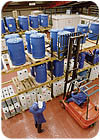
Just as journalists never cover the safe arrival of a passenger plane, the shipment of a chemical product without incident is an event too common to make the evening news. Yet every day hundreds of thousands of chemical shipments arrive safely at their destinations, whether shipped by air, by sea or over land.
Chemical manufacturers take the safe transportation of their products seriously, relying on safety initiatives that minimize distribution risks and establish procedures to respond should an incident occur. Like many chemical industry safety initiatives, transportation safety programs have largely grown out of Responsible Care®, a voluntary initiative that has resulted in America's chemical manufacturers having reduced emissions to the environment by 70% and having achieved a safety record that is four times better than the U.S. manufacturing sector as a whole.
At Dow Chemical, transportation safety begins with a distribution risk-review process. Through that process, Dow looks at chemicals that need to be shipped, the hazards of the chemicals, the origin and destination of the shipments, proper modes and packaging, and who the carrier should be. These distribution risk reviews are performed for all Dow businesses worldwide.
For most companies, the concern with transportation safety does not end when the shipment leaves the plant. Dow, for example, partners with its carriers to implement joint safety initiatives to deliver its products. These initiatives improve transportation safety and involve regular meetings between shipper and carrier safety directors, investigation and information sharing of all transportation incidents, and additional safety initiatives and programs.
"Our work with carriers has yielded promising results," says Henry Ward, Dow Transportation Safety and Security manager. On a worldwide basis, Dow manages over 600,000 hazardous material shipments each year with an extremely low accident rate. Over 99.97% of shipments reach their destination without incident. Fewer than two shipments per 1,000,000 involve an accident that results in the release of a hazardous material - and none of those have involved chemical exposure-related personal injuries.
"However, our ultimate goal is to have zero incidents," Ward says.
Smaller companies may have fewer transportation safety programs and initiatives, but also use a rigorous process based on the principles of Responsible Care. At Tomah Products in Wisconsin, every container that leaves the facility - including drums, tankwagons, isotainers, and rail cars - is specially sealed. The carrier and customer know that an unbroken seal means the shipment has not been compromised.
Furthermore, large and small companies alike work with preferred carriers to deliver their products. A carrier's performance and investment in safety equipment are just as important as its ability to make deliveries on time.
"We have a strong preference for carriers that are Responsible Care partners," says Greg Linder, vice president of Manufacturing at Tomah.
Tracking Transportation Safety
The transportation safety metrics of Responsible Care require companies to report distribution incidents and the volumes of chemical shipments. Between 1995 and 2002, the number of distribution incidents among Responsible Care companies declined 27% even while the volume of industry shipments increased by 11%.Programs and initiatives to improve transportation safety are only one part of the equation, however. Just as important are the safeguards chemical companies put in place to ensure each shipment arrives without incident.
To ensure the safe transportation of goods, the product must be reviewed opposite applicable regulatory requirements. Once the proper product classification is determined, it is critical to select the appropriate packaging for shipment. Consideration must be given to materials of construction, including compatibility. After packaging is determined, a carrier is selected based upon their compliance with the shipper's safety requirements. Before a shipment leaves the site, proper inspections are made in terms of equipment securement, paperwork, and container markings and labeling. Another key element in safe transportation is ensuring that carriers and shippers have comprehensive emergency response plans and organizations in place.
Community Involvement
Since there are hazards inherent to many chemical products, it is understandable that plant neighbors and communities through which shipments pass are also concerned about transportation safety issues. To get a better understanding of a community's concerns, many companies participate in local Community Advisory Panels (CAP). Regular meetings to explain transportation safety initiatives, employee and carrier training programs, and new regulations or legal requirements for chemical shipments provide CAPs with the information a community needs to evaluate the risks and rewards of chemistry.Article reprinted with permission of the American Chemistry Council from the May 2005 issue of American Chemistry, vol. 1 No. 1. To learn more about the American Chemistry Council's Responsible Care initiative, visit http://www.americanchemistry.com .